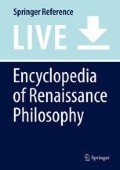Abstract
During the Renaissance there was no science of sound as we currently understand it. Conjectures about sound were provided by observations of particular acoustical phenomena incorporated in buildings or in open spaces, like whispering galleries or echoes as discussed in architecture. Sound was also a topic of interest for those who studied the functioning of natural bodies (i.e., voice and hearing), artificial instruments and machines (e.g., automata and war machines), among others. Although sound could not be identified as the subject matter of any science, it was attributed a relevant role in music treatises. It is assumed that the philosophical traditions involved in its study approached sound either as motion or as the object of hearing. However, up to the seventeenth century sound, as part of music, was mostly explored within the Aristotelian framework of subalternate sciences, being studied not as a perceived quality but as the natural quality of number, the actual object of music.
References
Adkins, Cecil. 1967. The technique of the monochord. Acta Musicologica 39 (1,2): 34–43.
Aristotle. 1984. In The complete works of Aristotle, ed. J. Barnes. Princeton: Princeton University Press.
Barbera, C. Andre. 1980. The persistence of Pythagorean mathematics in ancient musical thought. Ann Arbor: University of North Caroline at Chapel Hill.
Barbieri, Patrizio. 2004. The speaking trumpet: Developments of Della Porta’s “ear spectacles” (1589–1967). Studi Musicali 33 (1): 205–248.
Barker, Andrew. 2007. The science of harmonics in classical Greece. Cambridge: Cambridge University Press.
Biringuccio, Vanocchio. 1966. Pirotechnia. Trans. and ed. C.S. Smith, and M.T. Grudi. Cambridge, MA: MIT Press.
Bromberg, Carla, and Ana Maria Alfonso-Goldfarb. 2010. A preliminary study of the origin of music in Cinquecento musical treatises. IRASM 41 (2): 161–183.
Cohen, H.F. 1984. Quantifying music: The science of music at the first stage of the scientific revolution, 1580–1650. Dordrcht/Boston/Lancaster: D. Reidel Publishing Company.
Creese, David. 2010. The monochord in ancient Greek harmonic science. Cambridge: Cambridge University Press.
Crunelle, Marc. 1991. Acoustic history revisited. http://www.phy.duke.edu/~dtl/89S/restrict/CrunellePaper.pdf. Accessed 9 Mar 2016.
Dostrovsky, Sigalia. 1975. Early vibration theory: Physics and music in the seventeenth century. Archive for History of Exact Sciences 14: 169–218.
Dyer, Joseph. 2007. The place of musica in medieval classifications of knowledge. Journal of Musicology 24 (1): 3–71.
Gaffurio, Franchino. 1993. The theory of music. Trans. W.K. Kreyszig. New Haven/London: Yale University Press.
Gouk, P.M. 1982. Acoustics in the early royal society 1660–1680. Notes and Records of the Royal Society of London 36 (2): 155–175.
Gouk, P.M. 2006. The role of acoustics and music theory in the scientific work of Robert Hooke. Annals of Science 37 (5): 573–605.
Gozza, Paolo. 2000. Number to sound, The Western Ontario series in philosophy of science. Vol. 64. Dordrecht: Kluwer.
Johnstone, Mark A. 2013. Aristotle on sounds. British Journal for the History of Philosophy 21 (4): 631–648.
Masi, Michael. 1983. Boethian number theory: A translation of the De institutione arithmetica. Amsterdam: Rodopi.
McInerny, Ralph. 1990. Boethius and Aquinas. Washington, DC: The Catholic University of America Press.
Murdoch, John E. 1963. The medieval language of proportions: Elements of the interaction with Greek foundations and the development of new mathematical techniques. In Scientific change, ed. Alistair C. Crombie, 237–271. New York: Basic Books.
Pasnau, Robert. 1999. What is sound? Philosophical Quarterly 49 (196): 310–324.
Rico, Gilles. 2005. Music in the arts faculty of Paris in the thirteenth and early fourteenth centuries. Ph.D. Dissertation, University of Oxford.
Saito, Fumikazu, and Carla Bromberg. 2015. Measuring the invisible: A process among arithmetic, geometry and music. Circumscribere 16: 17–37.
Szabó, Árpád. 1978. The beginnings of Greek mathematics. Dordrecht/Budapest: D Reidel Publishing Company and Akadémiai Kiadó.
Teeuwen, Mariken. 2002. Harmony and the music of the spheres: The ars musica in ninth-century commentaries on Martianus Capella. Leiden: Brill.
Tronchin, L., I. Durvilli, and V. Tarabusi. 2008. The marvellous sound world in the “Phonurgia Nova” of Athanasius Kircher. Annals of Acoustics’08 Paris, Paris, pp. 4185–4190. http://webistem.com/acoustics2008/acoustics2008/cd1/data/. Accessed 10 Feb 2016.
Truesdell, Clifford. 1960. The rational mechanics of flexible or elastic bodies, 1638–1788. In Euleri Opera Omnia, 2nd Series, vol. II. Pt. 2, pp. 15–141.
Truesdell, Clifford. 1976. History of classic mechanics. Die Naturwissenschaften 63 (2): 53–62.
Valleriani, Matteo. 2012. Galileo’s abandoned project on acoustic instruments at the Medici Court. History of Science 50: 1–31.
Walker, Daniel P. 1978. Studies in musical science in the late renaissance. London: The Warburg Institute, University of London/Leiden: E. J. Brill.
Author information
Authors and Affiliations
Corresponding author
Editor information
Editors and Affiliations
Section Editor information
Rights and permissions
Copyright information
© 2017 Springer International Publishing AG
About this entry
Cite this entry
Bromberg, C. (2017). Acoustics. In: Sgarbi, M. (eds) Encyclopedia of Renaissance Philosophy. Springer, Cham. https://doi.org/10.1007/978-3-319-02848-4_889-1
Download citation
DOI: https://doi.org/10.1007/978-3-319-02848-4_889-1
Received:
Accepted:
Published:
Publisher Name: Springer, Cham
Print ISBN: 978-3-319-02848-4
Online ISBN: 978-3-319-02848-4
eBook Packages: Springer Reference Religion and PhilosophyReference Module Humanities and Social SciencesReference Module Humanities
Publish with us
Chapter history
-
Latest
Acoustics in Renaissance Sciences- Published:
- 24 April 2020
DOI: https://doi.org/10.1007/978-3-319-02848-4_889-2
-
Original
Acoustics- Published:
- 18 May 2017
DOI: https://doi.org/10.1007/978-3-319-02848-4_889-1

